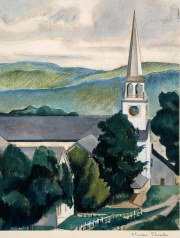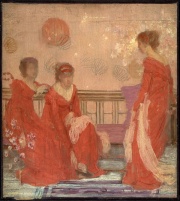Wax crayon
Description
A hard wax-based stick usually wrapped in a protective paper, used for drawing. Crayons are often sold in sets of colors, but as an artists' material it is often black. The popular Crayola® brand crayons were introduced in 1903 by Binney & Smith. Marketed for children, these first crayons contained Paraffin wax, Stearic acid, oil, and pigments. Today, many different quality wax crayons are produced for children as well as for artists. The base for the crayons is a wax (such as paraffin, Beeswax, carnauba, or Polyethylene) mixed with a colorant (pigment or dye). Some soft crayons have small amounts of an oil and/or fat (Stearic acid, Tallow) while some hard crayons have a filler (Kaolin, Talc). A few brands produce a water-soluble type crayon that contains an emulsified wax and Polyethylene glycol (Ellis and Yeh 1997).
Synonyms and Related Terms
crayon; wax stick; Crayola® [Binney & Smith]; school crayon; Neocolor I [Caran d'Ache]; Munsell Perma Pressed Crayons [Binney & Smith]
Other Properties
Soluble in petroleum hydrocarbons and chlorinated solvents.
Hazards and Safety
Halos may form when used on absorbent material. Bloom may form on surface.
Additional Information
° Binney & Smith: Crayola History° M.Holben Ellis, M.Brigitte Yeh,"Categories of Wax-based Drawing Media" WAAC Newsletter, Vol 19(3), 1997.
Additional Images
Authority
- Kurt Wehlte, The Materials and Techniques of Painting, Van Nostrand Reinhold Co., New York, 1975 Comment: p. 561
- The American Heritage Dictionary or Encarta, via Microsoft Bookshelf 98, Microsoft Corp., 1998 Comment: date 1902
- Encyclopedia Britannica, http://www.britannica.com Comment: "crayon." Encyclopædia Britannica. 13 Oct. 2004 .
- Website address 1 Comment: www.crayola.com (date 1903)
- Book and Paper Group, Paper Conservation Catalog, AIC, 1984, 1989


